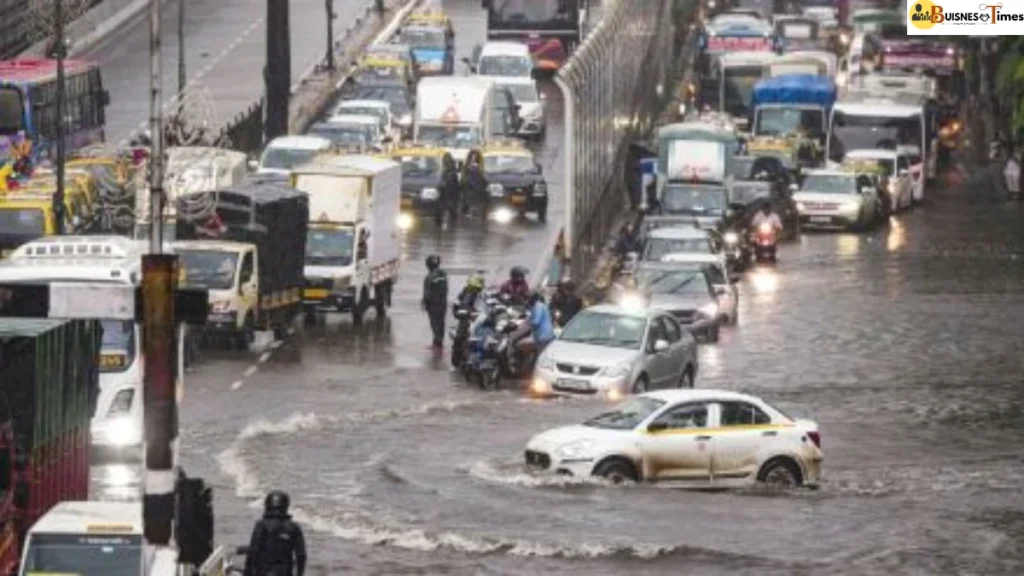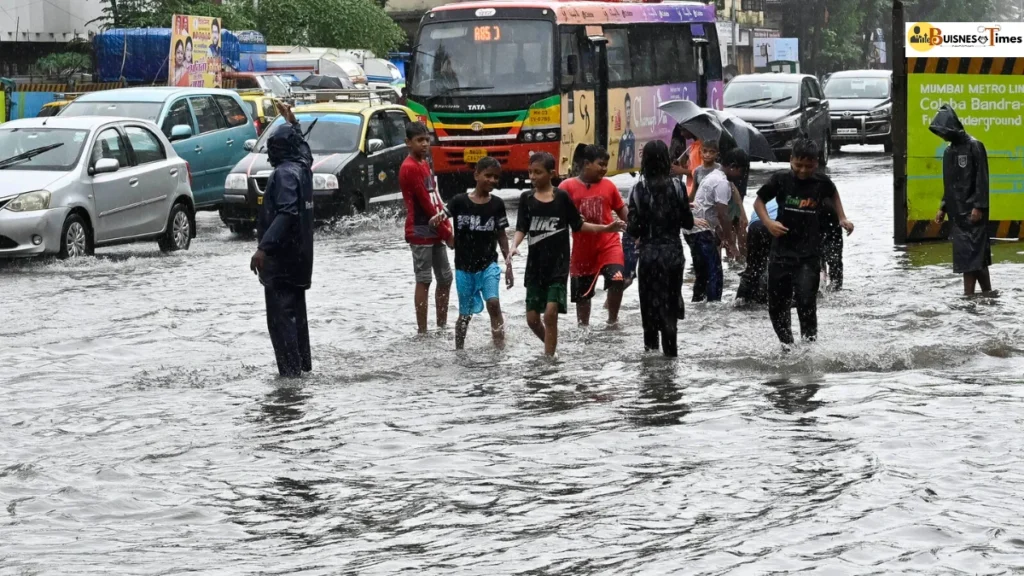Mumbai, August 20, 2025: Mumbai has been reeling under incessant downpours for four consecutive days, bringing the city to a near standstill. Local trains were delayed, several roads submerged, and low-lying areas reported severe waterlogging. Experts and meteorologists have now raised an extreme rainfall alert, warning that such intense weather events are becoming more frequent due to climate change and the alignment of multiple weather systems.

Also Read: Ola Electric Shares Soar 11% After Block Deal
The India Meteorological Department (IMD) has predicted that heavy rains will continue for the next 24 hours before subsiding into moderate showers. However, the damage and disruption already witnessed across Mumbai have once again brought to light the urgent need for adaptation strategies, early warning systems, and resilient infrastructure.
Mumbai Crosses Monthly Rainfall Average in Just 4 Days
After an unusually dry July, Mumbai experienced a sharp turnaround in mid-August. Between August 16 and August 19, the city recorded over 800 mm of rainfall, smashing past its monthly average of 560.8 mm.
This has led to authorities issuing an extreme rainfall alert for Mumbai and its suburbs, urging citizens to remain indoors unless absolutely necessary. Officials said that water levels in several reservoirs were rising rapidly, while low-lying areas like Dadar, Kurla, and Chembur reported waist-deep flooding.
Multiple Weather Systems Converge Over Mumbai
Meteorologists explained that the extreme rainfall alert was triggered by the alignment of multiple weather systems acting simultaneously over Maharashtra and surrounding regions.
- A low-pressure area over Vidarbha.
- A cyclonic circulation over the Northeast Arabian Sea.
- A depression over the Bay of Bengal.
- An active offshore monsoon trough.
According to Mahesh Palawat, Vice President of Meteorology and Climate Change at Skymet Weather:
“When such systems align together, they complement each other, intensifying weather activity. This has created vigorous monsoon conditions over Mumbai and coastal Maharashtra.”
The IMD has therefore extended its extreme rainfall alert, asking citizens to exercise caution and prepare for more intense showers.
Climate Change: The Hidden Force Behind Rising Rains
While heavy downpours are not new to Mumbai, scientists argue that climate change is amplifying rainfall patterns.

Dr. Raghu Murtugudde, Emeritus Professor at the University of Maryland and former IIT Bombay professor, described climate change as a “steroid” that is intensifying monsoon winds and pulling massive moisture from the Arabian Sea.
He explained:
“The northward swing of monsoon winds, influenced by global warming and warming in the Middle East, is injecting unprecedented moisture into the Western Ghats. This creates the conditions for extreme rainfall events.”
Studies show the Middle East is warming nearly twice as fast as other inhabited regions, increasing atmospheric instability. Between 1979 and 2022, nearly 46% of the additional rainfall over northwest India and Pakistan was attributed to this rapid warming. This global dynamic has made IMD’s extreme rainfall alert all the more urgent for Mumbai.
Mumbai’s Wettest August in Recent Years
Dr. Akshay Deoras, Research Scientist at the National Centre for Atmospheric Science, University of Reading, pointed out that Mumbai had just witnessed its driest July since 2015 before this sudden reversal.
Now, with multiple low-pressure systems combining, the city is enduring one of its wettest Augusts in years.
He cautioned that while the exact role of climate change requires more analysis, shorter and more intense downpours fit the scientific predictions of a warming planet. His remarks further validated the city’s extreme rainfall alert issued by weather agencies.
Early Warning Systems: The Need of the Hour
Experts stressed that the best way to deal with repeated extreme rainfall alerts is by improving early warning and flood management systems.
Dr. Subimal Ghosh, Institute Chair Professor at IIT Bombay, highlighted:
“The exponential warming of the Arabian Sea is driving massive moisture influx. We need robust nowcast and early warning systems that are citizen-centric, enabling people to make informed decisions during extreme rainfall events.”
IIT Bombay’s Mumbai Flood Monitoring System already provides real-time updates, but experts argue it must be scaled further to cover more wards and integrate with disaster management authorities.
Urban Planning & Coordination Failures
Even with repeated extreme rainfall alerts, Mumbai continues to struggle with waterlogging, traffic chaos, and infrastructure collapse. K.G. Ramesh, former Director General of IMD, emphasized the need for better coordination among agencies.
“Forecasting has improved, but dissemination and execution remain weak. We must identify high-risk zones, prepare evacuation plans, and ensure escape routes are operational. Preparedness is key to dealing with extreme rainfall events.”
Similarly, Dr. Vishwas Chitale from the Council on Energy, Environment and Water (CEEW) suggested mapping flood-prone areas, improving drainage, and adding green cover to absorb excess rainwater. He proposed using an Intensity-Duration-Frequency (IDF) mechanism to predict which parts of Mumbai will experience the heaviest rainfall. This could help authorities manage water discharge more effectively whenever an extreme rainfall alert is issued.
Flood Risk Management Action Plans
CEEW recently launched the Thane City Action Plan for Flood Risk Management 2024, analyzing 52 years of rainfall data. The plan includes:

- Ward-wise flood risk indices.
- IDF curves to forecast rainfall intensity.
- Identification of vulnerable hotspots.
Such initiatives are crucial as urban flooding becomes routine whenever IMD issues an extreme rainfall alert for Mumbai and surrounding cities.
India’s Megacities Under Growing Risk
Abinash Mohanty, Global Sector Head for Climate Change at IPE Global, warned that India’s megacities like Mumbai, Delhi, and Chennai are increasingly vulnerable to extreme rainfall events.
“Floods rank highest among natural disasters in terms of losses. For Mumbai’s 12 million residents, streets turning into rivers and vehicles getting submerged have become routine whenever an extreme rainfall alert is sounded.”
IPE Global is currently supporting Mumbai’s municipal corporation (BMC) in building an AI-ML-powered Multi-Hazard Risk Atlas. This project aims to climate-proof Mumbai’s infrastructure, livelihoods, and lives against recurring disasters.
Preparing for a Resilient Future
The four-day deluge in Mumbai is not an isolated event but part of a larger climate-driven pattern. With global warming intensifying monsoon winds and ocean warming driving moisture surges, extreme rainfall alerts are expected to become more frequent and severe in the coming years.
To build resilience, Mumbai must:
- Strengthen citizen-friendly early warning systems.
- Upgrade urban drainage and infrastructure.
- Foster better coordination between agencies.
- Implement climate adaptation strategies.
For now, Mumbai’s residents continue to brave the downpour, but the message from experts is clear: the city cannot afford to ignore extreme rainfall alerts anymore. Preparing today is the only way to prevent tomorrow’s disasters.
✅ Disclaimer (businestimes.com): This article is for informational purposes only. Weather forecasts are subject to change, and readers are advised to follow official IMD bulletins and government advisories during extreme rainfall alerts.

